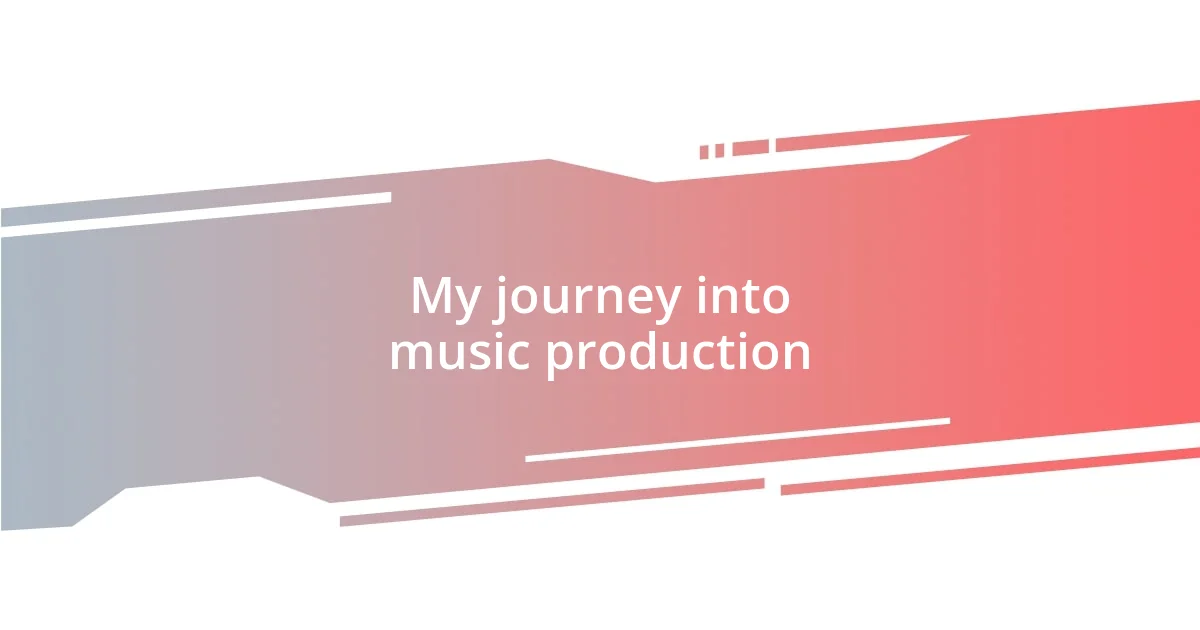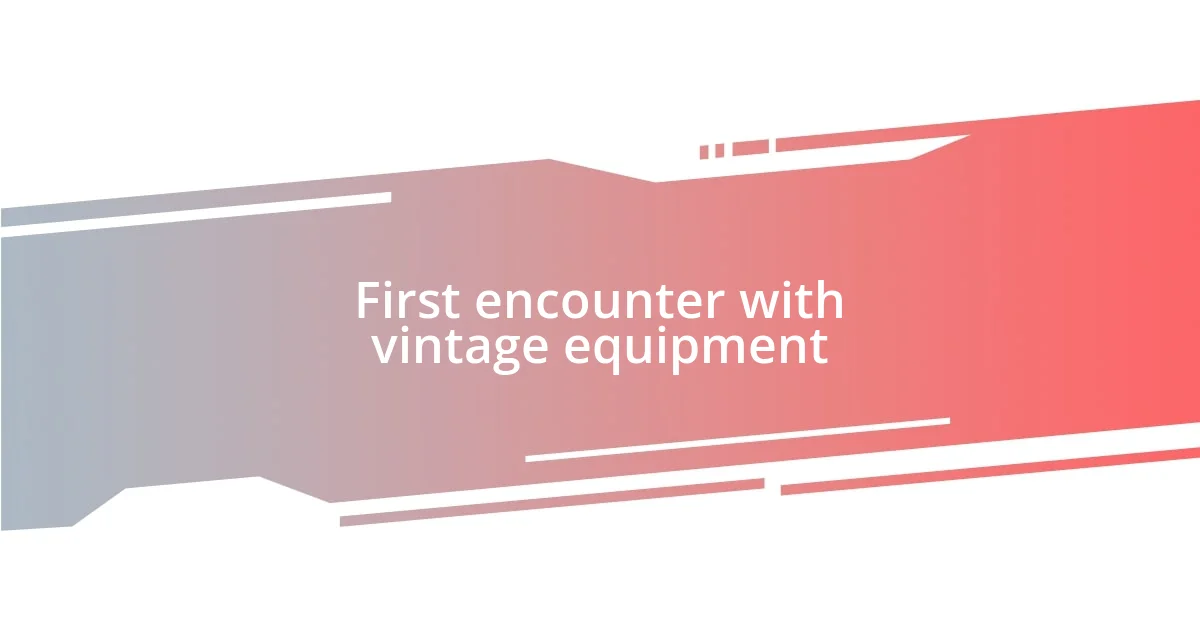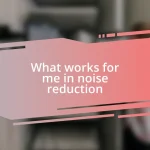Key takeaways:
- Discovery of analog gear transformed the author’s music production experience, bringing a deeper emotional connection to their work.
- Frustrations with digital tools led to a search for a more authentic and tactile creative process, enhancing spontaneity.
- Integrating analog equipment gradually and embracing its limitations can lead to unexpected creative breakthroughs.

My journey into music production
I still remember the moment I discovered my passion for music production. It was during a rainy afternoon when I stumbled upon some old gear in my dad’s attic, including a dusty synthesizer and a beat machine. The sheer excitement of tinkering with those buttons and knobs sparked something inside me—a yearning to create.
As I started experimenting, I found myself lost in the process, building beats that resonated deeply with my emotions. Have you ever felt that rush of adrenaline when you create something from nothing? I would often stay up late, headphones on, totally immersed in my sonic world, while the outside world faded away. The sheer joy of crafting sounds that reflected my feelings made me realize that music was more than just a hobby; it was a lifeline.
Over time, I made my way into digital production, but I always felt that something was missing. It wasn’t until I decided to take a deeper dive into analog gear that I sensed a profound connection with my music. The warmth and character these machines imparted to my tracks were something I had only dreamt of. Do you ever find yourself searching for that authentic sound? For me, analog gear opened a door to a creative realm where every note and hue felt alive, and my music transformed into an extension of who I am.

Early experiences with digital tools
In the early days of my music production journey, I dove headfirst into digital tools, eager to embrace what modern technology had to offer. With software like FL Studio and Logic Pro, I found myself amazed by the endless possibilities these platforms provided. It was like having a universe of sounds at my fingertips, but I often felt overwhelmed by the sterile quality of the produced tracks. Have you ever experienced a moment where you felt creative but powerless to express that creativity? For me, that feeling was all too familiar.
My first experiences with digital audio workstations (DAWs) felt like running on a treadmill—lots of movement, but not quite getting anywhere fulfilling. I vividly remember trying to replicate the catchy melodies I admired in my favorite tracks, spending hours adjusting MIDI notes and plugins. But despite my efforts, the sound always seemed flat. Why did my creations feel lacking in depth? Looking back, I realize that while digital tools were powerful, they often lacked the warmth and soul that I’d later discover in analog gear.
I also remember a time when I collaborated digitally with a friend, trading files and tweaking each other’s creations. Although it was exciting to share music over the internet, the process felt disconnected. The spark of real-time collaboration was absent, leaving us with a sense of detachment. I yearned for a tactile experience that digital tools just couldn’t provide. This realization fueled my desire to explore the heart of sound production, leading me eventually to the world of analog gear.
| Digital Tools | Analog Gear |
|---|---|
| High precision and flexibility | Warmth and character in sound |
| Overwhelming options | Tactile engagement and creativity |
| Detachment in collaboration | Real-time, hands-on interaction |

Frustrations with digital audio workstations
Despite my initial excitement with digital audio workstations, I soon felt a wave of frustration wash over me. I would often spend hours on end meticulously crafting tracks, only to hit an unexpected wall when the final mix left me cold. It felt as though I was chasing an elusive sound that simply wouldn’t materialize. The sterile clarity of digital recordings left me longing for something warmer, something that resonated on a deeper level.
- I constantly battled with the stiff grid of MIDI, trying to coax organic feeling from something so mechanical.
- The endless plug-in options often led to analysis paralysis, making it easier for my creative flow to stall.
- I remember cringing at how my mixes sounded lifeless and clinical, lacking the expressiveness I truly craved.
- The visual interfaces sometimes distracted me from the music itself, turning the creative process into a frustrating puzzle rather than an instinctive expression.
These frustrations were a turning point for me, igniting a desire to find tools that not only captured sound but also conveyed emotion in a way I had yet to experience. I knew deep inside that there had to be an avenue where my creativity could breathe and flourish.

First encounter with vintage equipment
My first encounter with vintage equipment happened almost by accident. While rummaging through a local thrift store one weekend, I stumbled upon an old analog synthesizer, its metallic casing worn but inviting. I remember feeling a rush of curiosity—what secrets could this relic hold? Connecting it to my setup felt like unearthing a hidden treasure, a bridge to a different era of music-making that I had only sampled digitally.
When I powered it up, the warm, rich tones poured out, wrapping around me like a cozy blanket. It was unlike anything I had heard in my digital creations. Suddenly, I was transported to a world where imperfections were celebrated, and every knob turned offered a new adventure. Have you ever felt a connection to an object that goes beyond its function? This synthesizer, with its quirks and character, felt alive, sparking creativity in ways I hadn’t thought possible.
As I explored its capabilities, each sound felt like a conversation rather than a sterile output. I recall a specific moment when a simple tweak on a filter created this lush atmosphere that completely transformed my track. It dawned on me that with this vintage gear, I wasn’t just producing sound—I was weaving emotion. This engagement struck me deeply and solidified my affection for analog equipment, paving the way for a journey I hadn’t even anticipated yet.

Transformative impact on my workflow
Shifting to analog gear drastically changed my workflow in ways I didn’t expect. I found myself spending less time fiddling with endless settings and more time immersed in the creative process. For me, it was freeing to turn knobs and pull faders instead of getting lost in a sea of digital menus. This tactile interaction brought a level of spontaneity that reinvigorated my passion for music-making. Have you ever found that physically engaging with your tools opens up new creative pathways?
The richness of the sounds I was able to capture made each session feel like an exploration rather than a chore. One evening, while recording with a classic reel-to-reel tape machine, I noticed how its inherent imperfections added a layer of warmth I had been craving. A simple mistake, a tape glitch, turned into a delightful surprise, enhancing the character of my track. It reminded me that sometimes, the most powerful moments in music arise from embracing the unexpected.
With analog gear, my workflow transformed into a more intuitive dance between me and the music. I began to trust my instincts, leaning into spontaneity rather than overthinking every decision. Each session was an adventure, and I found myself more focused, more aligned with my creative instincts. How exhilarating it felt to let go of rigidity and, instead, allow the music to lead the way! The analog world opened up a richer dialogue between my artistic vision and the sounds I created.

Tips for integrating analog gear
Finding a balance while integrating analog gear into your setup can feel like piecing together a puzzle. One tip that has worked wonders for me is to start small—choose one piece of analog equipment to incorporate at a time. I remember when I first added a vintage compressor to my chain. It made such a noticeable difference in my sound that it was like opening a door to a room filled with warmth and depth. As you get comfortable with each piece, you’ll start to discover how they enhance your creative process without feeling overwhelming.
Don’t be afraid to experiment; this is where the magic happens. I once spent an entire evening routing my synth through a different effects pedal just to see what sounds would emerge. The results were unpredictable, sure, but that’s exactly what I love about working with analog. Have you ever stumbled upon an unexpected combination that ignited your creativity? Trusting your instincts and playing around with signal flow can lead you to some of the most exciting and unique sound palettes.
Lastly, it’s crucial to embrace the inherent limitations of analog gear. I used to get frustrated when a certain piece wouldn’t behave as I expected, but I learned to view those moments as opportunities instead. Each imperfection can inspire a new direction or idea. One particular track started as a simple idea but transformed dramatically because of a circuit issue with my tape machine that added a strange loop. Sometimes, stepping outside of your comfort zone isn’t about perfecting the process but embracing the beautifully chaotic nature of making music with analog. How has a glitch or limitation in your workflow led you to something unexpected? Those moments are often the most revealing and can strengthen your connection to your art.















